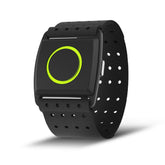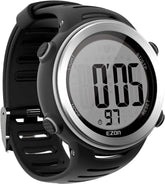Marathon Nutrition Navigation: GPS Running Watches for Fueling on the Go
Completing a marathon (26.2 miles) is as much about fueling as it is about training. For beginners, the difference between finishing strong and hitting “the wall” (glycogen depletion) often comes down to when and how much you eat during those long miles. A GPS running watch acts as your on-the-go nutrition navigator, turning distance, pace, and time into precise fueling cues. Whether you’re following a marathon training program for beginners or gearing up for race day, EZON’s GPS Series and Sports Watch Series take the guesswork out of fueling, ensuring you stay energized from start to finish.
Why Marathon Nutrition Depends on Precision
Marathons burn ~100–150 calories per mile—meaning a 150-lb runner will torch 2,600–3,900 calories over 26.2 miles. Without strategic fueling:
- Glycogen (your body’s primary energy source) runs out around mile 18–20, leaving you fatigued, dizzy, or unable to maintain pace.
- Dehydration (even 2% fluid loss) slows performance by 10% and increases cramping risk.
A GPS running watch solves this by:
- Tracking distance to trigger fuel stops (e.g., “Take a gel at mile 8, 13, and 18”).
- Calculating real-time calorie burn to match intake (e.g., “You’ve burned 600 calories—time for 30g carbs”).
- Logging weather and pace to adjust hydration (e.g., “Hot day + 8 min/mile = sip water every 10 minutes”).
Pre-Run Fueling: Prime Your Tank with Watch Alerts
The 24–48 hours before a long run or race set the stage for success. Use your GPS watch to time intake:
48 Hours Before: Carb Loading
- Aim for 8–10g of carbs per kg of body weight (e.g., 560–700g for a 70kg runner).
- Watch Hack: Use EZON R7’s (from GPS Series) “event reminder” to log meals. Its app breaks down macros, ensuring you hit carb targets without overeating (e.g., “Oatmeal + banana = 80g carbs—check!”).
3–4 Hours Before: Pre-Run Meal
- Eat 30–60g of low-fiber carbs (e.g., toast + peanut butter + honey) to top off glycogen.
- Watch Hack: Set R7’s alarm to trigger 3.5 hours before your run. This avoids rushing and gives food time to digest—critical for preventing stomach cramps.
30–60 Minutes Before: Quick Energy
- Sip 4–6 oz of water and eat 15–30g of fast-digesting carbs (e.g., energy gel + small banana).
- Watch Hack: R7’s “race mode” starts counting down from 30 minutes, vibrating when it’s time to fuel—no more “did I eat enough?” stress.
Fueling During Long Runs: Mile-by-Mile with GPS Guidance
Long runs (16+ miles) in your training program are where you practice race-day fueling. Let your watch map the plan:
Miles 1–6: Hydrate First
- Focus on fluid intake: 4–6 oz of water or sports drink every 2 miles (use R7’s GPS to mark water stops).
- Why: Your body still has glycogen stores—hydration prevents early fatigue.
- Watch Hack: R7 vibrates at 2-mile intervals, reminding you to sip. Its “sweat estimator” (based on pace and temperature) suggests adding electrolytes if it’s hot.
Miles 7–18: Carb Replenishment
- Take 30–60g of carbs every 45–60 minutes (e.g., energy gels, chews, or bananas).
- Pair with 4–6 oz of water (not sports drink) to avoid stomach upset from excess sugar.
- Watch Hack: Program R7 to alert at mile 8, 13, and 18 (key glycogen-depletion points). Its lap timer logs fuel times, so you review later: “Taking gel at mile 8 kept my pace steady—skipping mile 13 slowed me by 30 seconds/mile.”
Miles 19–26.2: Boost for the Finish
- Increase carb intake to 60–90g per hour (e.g., double up on gels) as glycogen runs low.
- Sip 6–8 oz of fluid every mile to combat late-race dehydration.
- Watch Hack: R7’s “final push” alert triggers at mile 20, reminding you to fuel aggressively. Its GPS shows distance to finish, so you know: “One more gel and I’ll have enough to sprint the last mile.”
Marathon Training Program for Beginners: Fueling by Phase
A 16-week plan, synced with EZON’s watches to build fueling habits:
| Phase | Long Run Distance | Fuel Focus | Watch Feature to Use |
|---|---|---|---|
| Weeks 1–4 | 6–10 miles | Practice hydration (no carbs needed) | R7’s 2-mile water stop alerts |
| Weeks 5–8 | 12–16 miles | Introduce 1 gel at mile 8 | Lap timer to log fuel response |
| Weeks 9–12 | 18–20 miles | 2 gels (miles 8 + 14) + electrolytes | C009Pro (Heart Rate Series) to check for fatigue spikes post-fuel |
| Weeks 13–16 | 20–22 miles | Full race fuel (3 gels + steady hydration) | R7’s “race simulation” mode to mimic marathon timing |
EZON GPS Watches: Your Fueling Co-Pilot
R7 (GPS Series): The Marathon Navigator
-
Key Features:
- 20-hour GPS battery (lasts the full marathon + warm-up).
- Customizable fuel alerts (set by mile or time) with vibration reminders.
- “Calorie burn tracker” (adjusts for weight, pace, and terrain) to match fuel intake.
- Weather sensor to suggest hydration tweaks (e.g., “90°F = drink 2 oz more per mile”).
T048 (Sports Series): Budget-Friendly Fuel Log
-
Key Features:
- Simple distance tracking for early training runs (no need for advanced metrics).
- 12-month battery to avoid mid-run dead watches during long runs.
C009Pro (Heart Rate Series): Effort Check
-
Key Features:
- Chest strap syncs with R7 to show how fuel affects heart rate (e.g., “After gel at mile 14, HR stabilized—fuel worked!”).
FAQs: Troubleshooting Fueling with GPS Watches
Q: How do I know if I’m eating too much/too little?
- Use R7’s post-run summary: A steady pace with no heart rate spikes means fueling is right. If pace drops 30+ seconds/mile post-fuel, you may need more carbs.
Q: What if I hate energy gels?
- R7’s app lets you log alternatives (dates, fig bars, or even potato chunks) to track carb intake—aim for 30g every 45 minutes, regardless of the source.
Q: How to adjust for hot weather?
- R7’s temperature sensor triggers extra hydration alerts: “>85°F = sip water every mile, not every 2 miles.” Add electrolytes to 50% of your drinks to replace lost sodium.
Finish Strong: The Fueling Advantage
Marathon success isn’t just about logging miles—it’s about fueling smart. With a GPS running watch from EZON’s GPS Series, you’ll navigate every mile with confidence, knowing exactly when to eat, drink, and push—so you cross the finish line with energy to spare.









